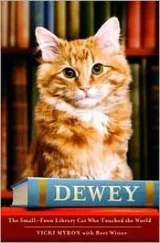Kim Knox was different. I could hear that clearly in her voice. Kim Knox desperately wanted children. She needed them, and it was a crushing blow when she found out she was unable to have them. She and her husband tried every fertility treatment short of in vitro fertilization, which they couldn’t afford. They researched adoption, but after more than a year of phone calls and meetings, they realized that even the cheaper alternatives were beyond their modest means. There was no single moment, Kim said, when the reality hit her. There were no breakdowns in the office; no sobs in the night; no dark mornings when Church Cat’s presence lifted her spirits just as her strength collapsed. There were tears with her husband, many thousands of them, but the emotional process was a gradual chipping away of her hopes, a slow and crushing collapse of all her dreams, not a sudden surrender, and Church Cat’s contribution was a constant affection, a daily warmth, more than one unforgettable act.
But that affection was important, more than Carol Ann or even I can understand. To Kim, Church Cat wasn’t just a cute cat. She was a source of comfort and strength. She was a friend Kim could put her maternal compassion and energy into when she had nowhere else to place it.
Be present. That’s the advice for helping people in pain. Be present for them , whatever they need. That, in a nutshell, was Church Cat.
And just as important, through that little cat, Kim built a local community of support. Through her, Kim became friends with Carol Ann Riggs and ultimately confided in her. With the help of the strewn papers and torn-up toilet paper, she developed the kind of warm, lighthearted relationship with the young pastor that allowed her to finally, in the quiet of the parsonage with only Church Cat as a witness, unburden her heart.
Does that change the story of Church Cat? Does it explain why a professional woman would spend her lunch break climbing through the window of an abandoned house? I don’t know. Kim’s husband, who was older, was on his second marriage and second career, as a schoolteacher. He had a son from a previous marriage, but the boy had been seriously ill his whole life. In 1999, as Church Cat was birthing her kittens in an old motel, the boy’s doctors recommended a transplant. Kim’s husband donated a kidney. He and Kim both understood that the time, physical recovery, and expense meant the end of their last faint hope of ever adopting a child of their own. But it was something they never hesitated to do. I cannot help but believe that when Kim Knox sat in that abandoned bedroom, softly encouraging Church Cat’s kittens to trust her, that she was taking a turn at motherhood. That she was being comforted by those soft little lives. That she was grieving, in her way, for what she could never have.
Then, in August 2002, Kim received a call from the young, now former pastor of Camden United Methodist Church. A woman had come to see him, the pastor told her. Her niece knew a young woman who could not afford to keep her baby. She was seven months’ pregnant, and she was searching for someone to adopt him.
Eight weeks later, in October 2002, Kim Knox drove five hours to meet the mother. She brought nothing but one change of clothes and a child’s car seat, still in the box. She refused to buy anything else. She was terrified, after all those years of struggle, that something would go wrong.
Two days later, she was in the delivery room when her adopted son, Noah, entered the world. The mother spoke no English, but she begged Kim in broken syllables and gestures to stay with her in the recovery room, to let her hold, for a moment, the newborn baby. They saw the mother again when the boy was eleven months old. They drove to Birmingham, a few hours from Camden, to meet her. The woman cried, smiled, thanked them in broken English, hugged her child, and then disappeared. Kim could feel her heartbreak, almost as strongly as she had felt her own. But where she went, or why, Kim has no idea.
“We were so thrilled when we met Noah,” Ms. Carol Ann said. “He was the cutest thing. The whole congregation absolutely loved him.”
In 2005, Kim and her husband moved back to Laurel, Mississippi, Kim’s hometown. They loved Camden, but they had no relatives in the area, and they wanted to raise their boy surrounded by family. They moved just two months before Hurricane Katrina. Although they were a hundred miles from the coast, they watched in horror from their aunt Lee’s house as trees shattered and toppled. They clutched their child and hoped that Church Cat’s son, Chi-Chi, who they had left in their nearby rental cottage, survived the storm.
He did, but that is yet another story. Suffice it to say, for this story, that Church Cat wasn’t just a pretty face, that her love gave Kim Knox, and perhaps others in Camden, a calming presence in times of need. And that Kim Knox, with the help of a gentle cat and a kindly pastor, survived her time of trials and saw her dreams of motherhood come true. And that Church Cat’s son, Chi-Chi, although never a friendly cat like his mother, loved his little brother Noah with a ferocity that surprised even Kim, who will forever appreciate the warmth and intelligence of cats.
NINE
Dewey and Rusty

“I was lying upside down on the front seat with my head under the dashboard and I felt something on my chest. I looked up and here’s this little orange and white kitty cat. Estimated age six to eight weeks. And he was on my chest meowing. I looked up and said, ‘Well, hey, Rusty, how are you?’ I petted him, and he laid right down on my chest, and he just stayed there. He never left.”
Part I
For those of us in northwest Iowa, Sioux City is the hub of activity. We go there for Christmas shopping, for theatre and entertainment, for business meetings and dancing and advanced medical care. The big city, we mutter in Spencer, shaking our heads. Railroad town, we say, because you can’t drive three miles in Sioux City without crossing a railroad track. Too crowded. Too much traffic.
But that’s not entirely true. The truth is that Sioux City is just different from the rest of the world out here on the high plains. Towns here are mostly flat, sunny, and open to the sky. Sioux City is dense, industrial, and tall, full of church steeples and factory towers. It’s one of those old towns, like Pittsburgh or Cleveland, that seems to have been carved by brute force out of the ground. Pittsburgh had steel. Cleveland had oil. Sioux City was built for cattle. They came a thousand head at a time down the Missouri River or on overland trails to be penned and fattened and slaughtered in the raw brick factories along the river, then shipped back out on railroad cars.
The Missouri River, the reason for the location of the town, brought other things as well: granite, grain, steel, hides, and the men who raised and built and transported them. Downtown Sioux City featured the best restaurants and hotels in the region. The warehouses of Lower Fourth Street, on the edge of downtown, were the center of vice—mostly the liquid kind—for a hundred miles around. The workingmen’s homes stretched into the hills carved by the river and its tributaries, punctuated by Catholic and Orthodox churches for the mainly Eastern European immigrants building the city one stone at a time. On a bluff sat the octagon, an old steamboat captain’s house, built so he could watch the river. On the highest hill, Rose Hill, were the mansions of the slaughter bosses and factory owners, built mostly of the rough-hewn Sioux Falls granite that was always being shipped down the river and moved out to the rest of the world.
Читать дальше













